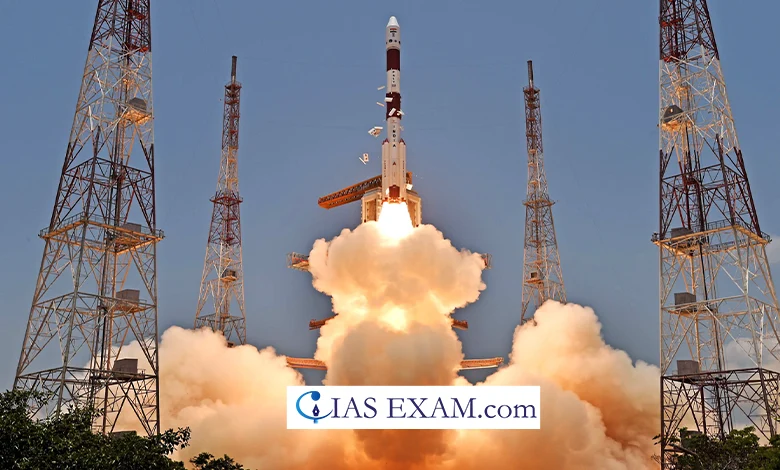ISRO Achieves ‘Zero Orbital Debris’ Goal
Syllabus: Science and Technology, Space Technology [GS Paper-3]

Context
On the recent launch of PSLV-C58/XPoSat mission performed by International Space Research Organisation (ISRO), where any debris shall not be left in space may be ensured i.e. zero orbital debris. By establishing the causality for it, it will touch the target of this act – rocket launching. Such modules will constitute a phase of a transiting rocket for the launch of a space station.
Mission PSLV-C58/XPoSat
- ISRO launched a mission called PSLV-C58/XPoSat, ensuring it left no debris in space.
- This second stage transformation into a small space station namely POEM-3 (PSLV Orbital Experimental Module-3) brought the mission to a logical close with the module being finally deorbited and re-entering the Earth’s atmosphere.
POEM-3: An Innovative Solution
-
- The VSSC, (Vikram Sarabhai Space Centre) has heightened an experiment called POEM, which is a test spacecraft.
- The second stage of the PSLV rocket, which normally should be thrown away to space junk, is used in it.
- Finally of POEM, this last phase will be employed as a secure laboratory for accomplishing investigations here.
- The project has modern equipment NGC System for maintaining the platform attitude and it will have two sources of power – it will have solar radiation panels and Li-Ion battery. It will navigate using various sensors.
- Achievements of POEM-3: The POEM-3 module featured nine payloads and completed 400 orbits around the Earth by its 25th day. During this time, the payloads were operationalized to perform their experiments. This approach not only prevents the creation of space debris but also provides a cost-effective platform for space-borne experiments.
Zero orbital debris milestone
- The International Space Agency made a strategic decision to lower POEM-3’s altitude from 650 km to 350 km to avoid collisions with orbiting objects.
- This tactical move significantly reduced the time it took for POEM-3 to re-enter and disintegrate in Earth’s atmosphere.
- To ensure safety, POEM-3 underwent passivation, which tanked residual fuel on its board.
- This step minimised the risk of an explosion and created less space debris. On March 21, 2024, POEM-3 returned to Earth’s atmosphere, dying in flames.
- The deorbiting and passivation manoeuvres of the PSLV-C58/XPoSat mission resulted in a minimal number of obsolete objects remaining in Earth’s orbit, demonstrating the sustainability of space and reducing hazards for future space flights.
Space Debris
- Space debris is increasing because of the many satellites in orbit around Earth, and when it comes to low Earth orbit (LEO) it is where most spacecraft, rocket, and retired satellite fragments are accumulating.
- Many of the planes used for navigation, communication, and intelligence performance are in the Low Earth Orbit (LEO), which is an area of about 100-2000 km of the Earth’s surface and is above the Earth.
- Chunks which are smaller are freed from the orbits as a result of the large number of collisions as well as on-orbit breaks brought about by the tests of anti-satellite and the increasing population of objects in heavenly bodies.
What is the space agency’s debris management strategy?
- ISRO has successfully transformed the last stage of the Polar Satellite Launch Vehicle (PSLV) into the PSLV Orbital Experimental Module (POEM) for short-term space-inherent conditions studies.
- The POEM module’s strategy involves lowering the orbital altitude to bring it to a lower altitude for early reentry with the Earth’s atmosphere and passivation to remove residual propellants and avoid debris break-up risks.
- The POEM unit consists of various space experiment gadgets delivered by new generation enterprises (NGEs) through IN-SPACe, the Indian National Space Promotion and Authorization Centre.
- The satellite operations team, including ISRO’s System for Safe and Sustainable Spacecraft Operations Management (IS4OM), closely monitors and analyses the orbital decay from the beginning of the mission.
- The POEM incorporates advanced technologies, such as total avionics in a single-chain configuration, industrial-grade electronics modules, standard interfaces for telemetry and telecommand, and new algorithms for navigation in orbit. ISRO is dedicated to international collaboration and regulation, ensuring that satellite fabrication, performance, and EOL measures are met globally. It also collaborates with other space agencies and organisations to set up rules forbidding debris creation and promote responsible deployment practices.
- Active Debris Removal (ADR) is a major domain of debris management, involving the development and use of robotic systems, satellites with nets, harpoons, or robotic arms for capturing debris with large orbital objects.
Conclusion
ISRO’s ‘zero orbital debris’ goal is a testament to its commitment to sustainable space exploration. By implementing innovative strategies and technologies, ISRO ensures that its missions do not contribute to the growing problem of space debris, thereby safeguarding the orbital environment for present and future space endeavours.
Source: The Hindu
UPSC Mains Practice Question
Q.Discuss the significance of ISRO’s attainment of the ‘zero orbital debris’ goal in the context of space sustainability and international space exploration efforts.





.png)



